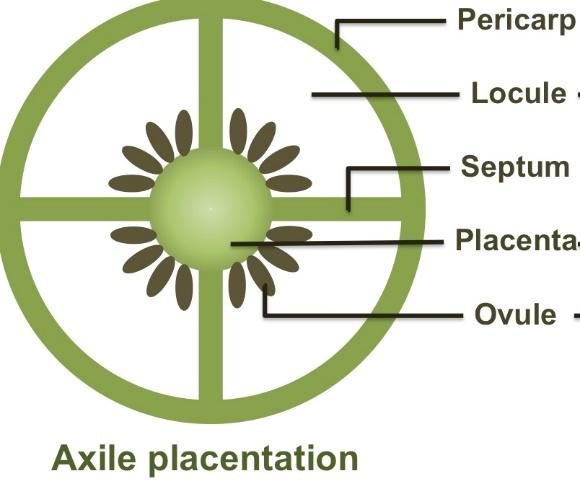
Where can Axile Placentation be seen?
Answer
412.5k+ views
Hint:Placentation is defined as the arrangement of ovules inside the ovary. In the flowering plants, there are numerous types of placentation. Free central (septa is absent), parietal (ovules at inner wall or periphery), marginal (ovules at ridge through the ventral suture of ovary), axile (around the ovary’s centre) and basal (in base of ovary) are the different types of placentation.
Complete answer:
The ovules are axial in the axial placentation. China rose, tomato, cotton and lemon are the examples of the plants exhibiting axial placentation. It is usually seen in multilocular ovaries, where the placentation is present along the axis of the fusion of ovaries. The arrangement is common in liliaceae, rutaceae and solanaceae families. Hibiscus rosa-sinensis exhibits axial placentation. The ovules are arranged along the placenta's central axis. Radial spokes section the ovary with placentae in distinct locules. The number of chambers present is equivalent to the number of carpels. The placentation can be seen in bicarpellary, multicarpellary and multilocular ovaries. It occurs in syncarpous pistils. Ovaries are divided into two or more chambers. Placenta occurs in the centre, where the septae get together, forming axile columns with the formation of ovules. In shoe flowers (pentalocular), it can be seen. In lemon, around the compound ovary, ovules are seen on an axis, which are formed from a jointed septae.

Note:
Ovules are attached inside the flower’s ovary via funiculi. Funiculi is the counterpart of umbilical cord. The funiculi attach to the part of the ovary, which is called the placenta. Placentation’s main function is to connect walls of the ovary with the flower. Placenta helps in providing nutrients to the developing embryo. It serves as a cushion-like structure for connection.
Complete answer:
The ovules are axial in the axial placentation. China rose, tomato, cotton and lemon are the examples of the plants exhibiting axial placentation. It is usually seen in multilocular ovaries, where the placentation is present along the axis of the fusion of ovaries. The arrangement is common in liliaceae, rutaceae and solanaceae families. Hibiscus rosa-sinensis exhibits axial placentation. The ovules are arranged along the placenta's central axis. Radial spokes section the ovary with placentae in distinct locules. The number of chambers present is equivalent to the number of carpels. The placentation can be seen in bicarpellary, multicarpellary and multilocular ovaries. It occurs in syncarpous pistils. Ovaries are divided into two or more chambers. Placenta occurs in the centre, where the septae get together, forming axile columns with the formation of ovules. In shoe flowers (pentalocular), it can be seen. In lemon, around the compound ovary, ovules are seen on an axis, which are formed from a jointed septae.

Note:
Ovules are attached inside the flower’s ovary via funiculi. Funiculi is the counterpart of umbilical cord. The funiculi attach to the part of the ovary, which is called the placenta. Placentation’s main function is to connect walls of the ovary with the flower. Placenta helps in providing nutrients to the developing embryo. It serves as a cushion-like structure for connection.
Recently Updated Pages
Master Class 11 Economics: Engaging Questions & Answers for Success

Master Class 11 Business Studies: Engaging Questions & Answers for Success

Master Class 11 Accountancy: Engaging Questions & Answers for Success

Master Class 11 English: Engaging Questions & Answers for Success

Master Class 11 Computer Science: Engaging Questions & Answers for Success

Master Class 11 Maths: Engaging Questions & Answers for Success

Trending doubts
State and prove Bernoullis theorem class 11 physics CBSE

1 ton equals to A 100 kg B 1000 kg C 10 kg D 10000 class 11 physics CBSE

State the laws of reflection of light

One Metric ton is equal to kg A 10000 B 1000 C 100 class 11 physics CBSE

Difference Between Prokaryotic Cells and Eukaryotic Cells

1 Quintal is equal to a 110 kg b 10 kg c 100kg d 1000 class 11 physics CBSE




